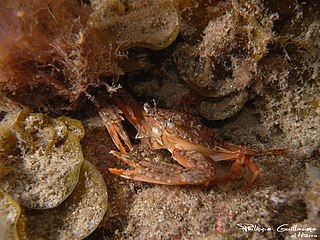
Portunus is a genus of crabs which includes several important species for fisheries, such as the blue swimming crab and the Gazami crab. Other species, such as the three-spotted crab are caught as bycatch.

Homarus is a genus of lobsters, which include the common and commercially significant species Homarus americanus and Homarus gammarus. The Cape lobster, which was formerly in this genus as H. capensis, was moved in 1995 to the new genus Homarinus.
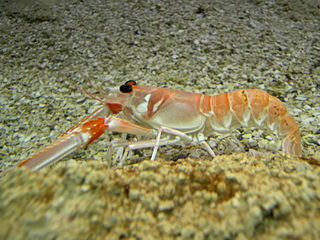
Nephrops is a genus of lobsters comprising a single extant species, Nephrops norvegicus, and several fossil species. It was erected by William Elford Leach in 1814, to accommodate N. norvegicus alone, which had previously been placed in genera such as Cancer, Astacus or Homarus. Nephrops means "kidney eye" and refers to the shape of the animal's compound eye.
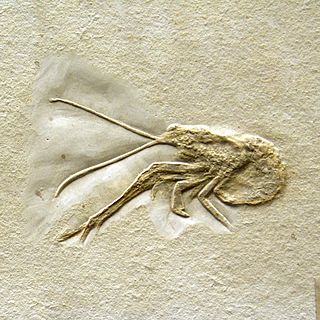
Glypheidea is an infraorder of lobster-like decapod crustaceans, comprising a number of fossil forms and the two extant (living) genera Neoglyphea and Laurentaeglyphea: The infraorder was thought to be extinct until a living species, Neoglyphea inopinata, was discovered in 1975. They are now considered "living fossils", with over 256 fossil species discovered, and just two extant species.
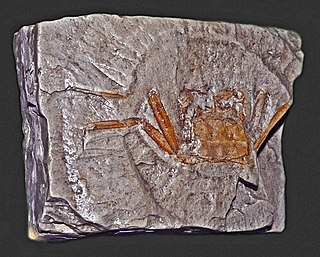
Retroplumidae is a family of heterotrematan crabs, placed in their own (monotypic) superfamily, Retroplumoidea.
Carcineretidae is a prehistoric family of heterotrematan crustaceans. They are only known from Cretaceous fossils. These crabs are tentatively placed in the superfamily Portunoidea and resemble the swimming crabs (Portunidae) in having some paddle-shaped pereiopods. But it is not certain that this placement is correct, as the Carcineretidae also show some similarities to the Matutidae of superfamily Leucosioidea and the Goneplacidae of superfamily Xanthoidea.

Carpilioidea is a superfamily of crabs containing a single extant family, Carpiliidae and three extinct families. The modern range of the family includes the Indo-Pacific, Western Atlantic and Caribbean Sea. The fossil record of the group extends back at least as far as the Paleocene.

Eryonidae is a family of fossil decapod crustaceans which lived from the Upper Triassic to the Lower Cretaceous. It contains four genera: An aggregation of three unidentified eryonids was reported in 2012 inside a Late Jurassic ammonoid of the species Harpoceras falciferum; they represent the earliest evidence of gregarious behaviour in decapods.

Hepatus is a genus of crabs in the family Aethridae, containing seven extant species, plus some fossil species:
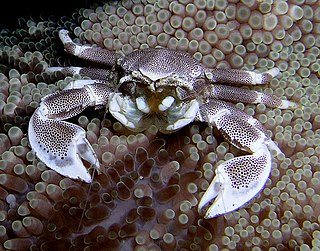
The Galatheoidea are a superfamily of decapod crustaceans comprising the porcelain crabs and some squat lobsters. Squat lobsters within the three families of the superfamily Chirostyloidea are not closely related to the squat lobsters within the Galatheoidea. The fossil record of the superfamily extends back to the Middle Jurassic genus Palaeomunidopsis.

Linuparus, the spear lobsters, is a genus of medium-sized to large spiny lobsters in the family Palinuridae. It contains four extant species found at depths of 30–500 m (100–1,640 ft) in the Indo-Pacific, and 32 fossil species, ranging from the Early Cretaceous to the Oligocene. L. trigonus is the only extant species also known from the fossil record.
Tricarina is an extinct genus of crustaceans in order Isopoda, known from a single incomplete fossil specimen from the Cretaceous of western Iran. It has a flattened body with three longitudinal ridges, which give it its name.
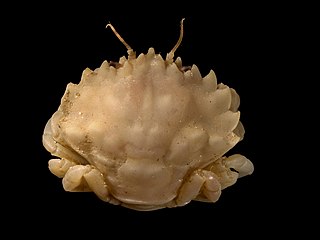
Pirimelinae is a subfamily of crabs belonging to the family Carcinidae in the order Decapoda. It previously was treated as a family.

Notahomarus is a genus of fossil lobster belonging to the family Nephropidae that is known from fossils found only in Lebanon. The type species, N. hakelensis, was initially placed within the genus Homarus in 1878, but it was transferred to the genus Notahomarus in 2017.

Pseudastacus is an extinct genus of decapod crustaceans that lived during the Jurassic period in Europe, and possibly the Cretaceous period in Lebanon. Many species have been assigned to it, though the placement of some species remains uncertain and others have been reassigned to different genera. Fossils attributable to this genus were first described by Georg zu Münster in 1839 under the name Bolina pustulosa, but the generic name was changed in 1861 after Albert Oppel noted that it was preoccupied. The genus has been placed into different families by numerous authors, historically being assigned to Nephropidae or Protastacidae. Currently, it is believed to be a member of Stenochiridae.

Stenochiridae is a family of fossil decapod crustaceans which lived from the early Jurassic to late Cretaceous periods. It is the only family in the superfamily Stenochiroidea. Fossils of stenochirids are known from Europe, Japan, Chile and Australia.
Palaeophoberus is an extinct genus of decapod crustaceans that lived from the Aalenian to Tithonian stages of the Jurassic period. Its fossils have been found in Germany and France.
Chilenophoberus is an extinct genus of decapod crustaceans that lived during the Oxfordian stage of the Late Jurassic period in what is now Cordillera de Domeyko, Chile. The genus contains a single species, Chilenophoberus atacamensis.
Tillocheles is an extinct genus of decapod crustaceans that lived during the Cretaceous period. Two species are currently placed in the genus. Fossils of the earlier type species, T. shannonae, have been found in Queensland, while remains of the later species, T. kaoriae, are known from Hokkaido.

Protastacus is an extinct genus of decapod crustaceans that lived in what is now Germany during the early Cretaceous period. The type species is P. politus, and a second species, P. antiquus, is also assigned to the genus. Protastacus grew to around 10 cm (3.9 in) long and had a mostly crayfish-like appearance, with enlarged pincer-bearing appendages and a segmented abdomen. Though formerly assigned to the Astacidae or Nephropoidea, it is currently placed as the only genus in the family Protastacidae, which in turn is the only family in the superfamily Protastacoidea.














